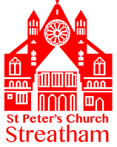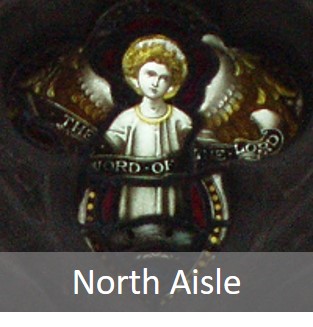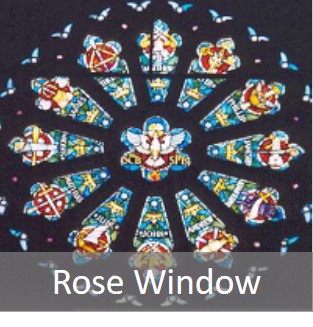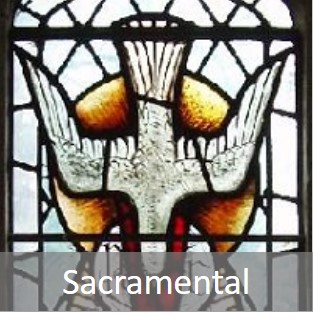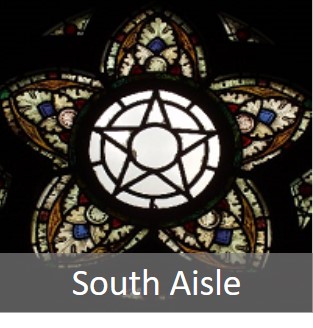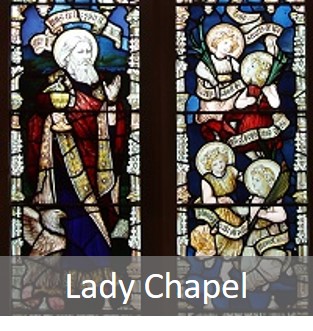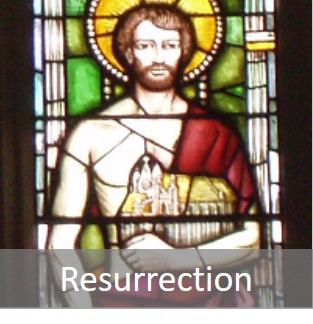Stained Glass – Rose Window
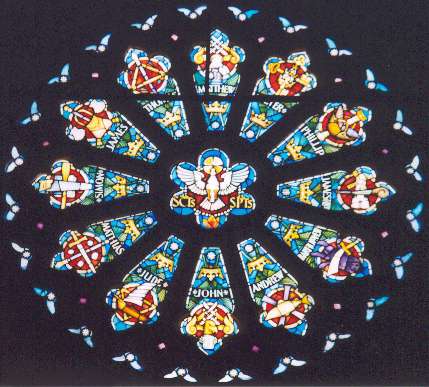
We now reach the West-end of the building.
The original Inscription reads:
To the Glory of God in memory of Philippina Pocock who died May 21st 1898. The Rose Window was provided by her husband Henry Pocock. I.P.
This window was reinstated in 1953 by Lawrence Lee and restored in 1994 by a generous bequest from Mabel Longmore.
Each of the twelve points of the window represents an apostle with a symbol. The following notes explore the references to the twelve apostles.
St Matthew
He is holding a tablet inscribed with the letter M. He was a tax collector in the service of Herod Antipas. He is sometimes called Levi and was possibly martyred in Ethiopia or Persia. The Gospel of Matthew, written between AD 50 and AD 100, does not give the name of its author, but from very early on Matthew has been accepted as its writer.
St Peter
The fisherman; he was brother to St Andrew and was married. Jesus called him ‘Kepha’ (Aramaic for ‘Rock’) and conferred on him the keys of the Kingdom of Heaven and the power of binding and loosing sins. We read of St Peter’s promise to Jesus and the tragic remembrance of the cock-crow. After his resurrection Jesus appeared to St Peter, and he was commanded to ‘Feed my lambs’ and Feed my sheep’. He was martyred under Nero, possibly crucified head downwards and may have been buried under the place where the altar of the Vatican basilica now stands.
St Philip
He came from the lakeside town of Bethsaida in Galilee, the home town of Peter and Andrew. Philip went straight to Nathanael, told him he had found the Messiah, and introduced him to Jesus. Faced with a crowd of five thousand hungry people, Jesus tested Philip’s faith. ‘Where can we buy enough bread to feed all these people?’ he asked. Philip was wondering where the money would come from. But Jesus fed them all from five small loaves and two fish. Philip possibly preached the Gospel in Phrygia and died at Hierapolis. The window shows a basket of bread and fish.
St James-the-Less
Son of Alphaeus, sometimes said to be Jesus’s brother, although this is in question. James did not believe that Jesus was the Messiah until he saw him after the resurrection. James is said to have presided over the Christian Community in Jerusalem as bishop and to have been martyred there. Josephus records that James, was stoned to death in AD 62. The epistle of James in the New Testament is often attributed to James, the Lord’s brother. This panel shows a windmill.
St Matthias
He was chosen to fill the place left vacant by the traitor Judas Iscariot. Unreliable accounts tell of his martyrdom and crucifixion.
St Jude
Sometimes called Thadaeus or Lebbaeus: he is sometimes identified with Jude, the brother of James and reputed to be writer of the Epistle of Jude in the New Testament. He is believed to be a powerful intercessor for those in desperate trouble.
St John
A Galilean fisherman, who with his brother James (the Greater) was called by Jesus while mending their nets. Jesus nicknamed them ‘Sons of Thunder’, so they were probably excitable and quick-tempered. They accompanied him at the Transfiguration and in Gethsemane. By tradition, St John is ‘the disciple whom Jesus loved’. Jesus confided the care of his mother to him; he ran before Peter to the tomb on the morning of the resurrection. He first recognised the risen Lord by the Sea of Tiberius. He is associated with St Peter at the healing of the lame man in the temple. He shared St Peter’s imprisonment and went with him to Samaria. St Paul names him with Peter as pillars of the Church in Jerusalem. John’s Gospel, written in about AD 90 probably contains the reminiscences of John. This panel shows a pattern of crossed swords, an eagle’s head and a small tablet bearing the letter ‘J’.
St Andrew
A Galilean fisherman, the first called of the followers; later he brought his brother (St Peter) to Jesus. He is mentioned several times in the Gospels, but accounts of his later life are unreliable. The story that he was martyred on an X-shaped cross did not appear until the late middle ages. He is the patron saint of Scotland and the panel shows his emblem, a saltire cross ‘X’.
St Bartholomew
Little is known about him. He was a Cypriot Jew, closely associated with the work of St Paul, until they quarrelled over John Mark. He was sent to the growing Christian Centre at Antioch, and brought Paul from Tarsus to help him; later he went with Paul on the first missionary journey, starting with Cyprus. The panel shows a human figure with a large curved sword superimposed.
St Simon
Sometimes called ‘the Cananean’ and sometimes ‘the Zealot’. He was one of the twelve called by Jesus, but nothing else of certainty is known about him. The Zealots were an extreme Jewish nationalist group pledged to drive out the Romans. The panel shows a saw, an oar and a book.
St James-the-Greater
A fisherman and brother of St John. He was with Peter and John at the Transfiguration and at Gethsemane. He was the first Apostle to be martyred, being killed for his faith by order of Herod Agrippa I. A Spanish tradition has it that he visited Spain and preached the Gospel there, but the story is now discredited. The shrine of Santiago de Compostella has been a centre of pilgrimages since the later middle ages and he is often represented as a pilgrim with a scallop-shell, the mendicant’s begging-bowl. A pilgrim’s pouch, staff and scallop-shells are shown.
St Thomas
Also called ‘Didymus’, the twin. A fervent follower of Jesus, he had doubts about the resurrection. He was not with the disciples when Jesus appeared to them on the first Easter day. He said he would not believe Jesus was alive again until he saw and touched the scars. A week later, Thomas saw Jesus for himself. ‘My Lord and my God’, he said. The story of his mission to India is regarded as unlikely, although he may have reached southern India.

